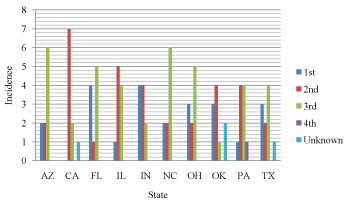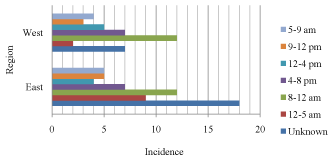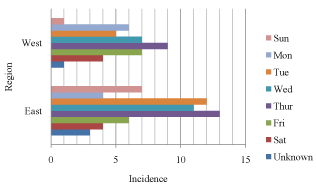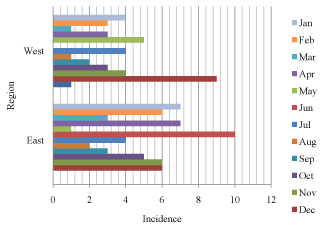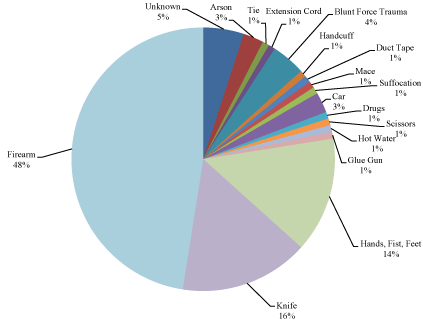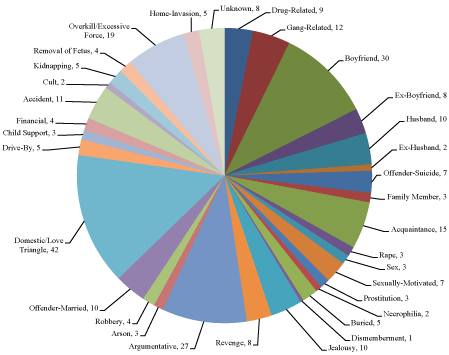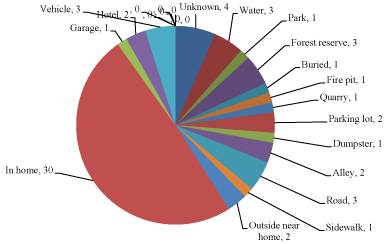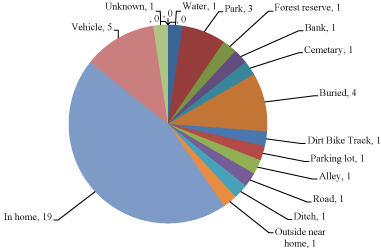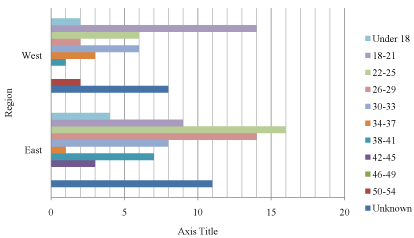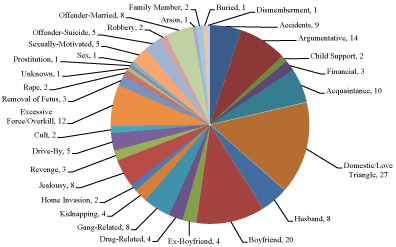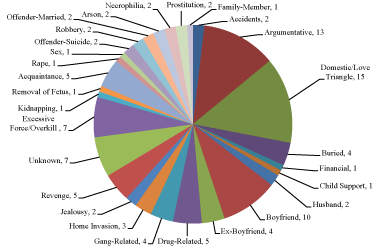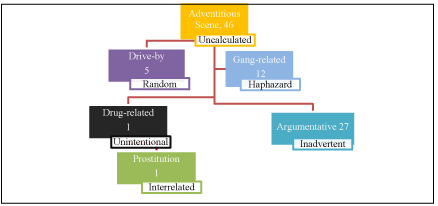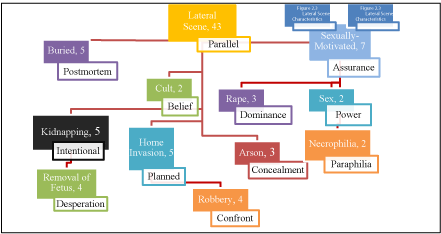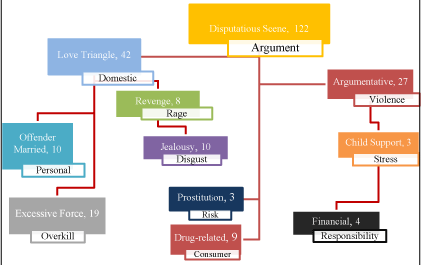
Review Article
Austin J Forensic Sci Criminol. 2014;1(1): 9.
Exploring Patterns of Perpetration and Victimization: Establishing Baseline Typologies for Profiling the Murders of Pregnant Women
Erica Hutton1*, Sarah A Baker1 and Nicole K Procise2
1Department of Criminal Justice, Psychology, & Social Sciences, Trine University, USA
2Ivy Tech Community College of Indiana, USA
*Corresponding author: Erica Hutton, Department of Criminal Justice, Psychology, & Social Sciences, Trine University, 1 University Avenue, Angola, IN 46703, Best Hall 115-H, USA
Received: October 29, 2014; Accepted: December 02, 2014; Published: December 05, 2014
Abstract
The following research study purports that there are relative perpetration and victimization patterns prevalent amongst the investigation of pregnant women that have been murdered. The researchers completed a national research study comparing approximately 100 cases of homicide in which the victim was a pregnant female. The research design encompassed a qualitative method, revealing pertinent data regarding perpetration patterns for the purpose of appraising emergent themes of offender and victimization classifications. The results of the study yielded a data set that was innovative, establishing distinctive patterns and profiling typologies in regards to the investigation of criminality, perpetration, and victimization in homicide cases of pregnant females.
Keywords: Homicide; Criminality; Typology; Profiling; Offender; Victimization; Perpetration; Investigative psychology; Motive
Introduction
The identification associated to the causative factors of homicide has been on the forefront of society and researchers for quite some time. Murder is embraced as an authoritarian phenomena in which the right to live is denied by the victim and entitlement is ultimately warranted for the perpetrator to employ various modalities to kill and dominate another [1]. In addition, the notion of harming populations that are deemed to have a more vulnerable disposition than others within society have led investigators to gather data associated to the various patterns of perpetration and victim selection alike. For example, investigators are curious as to why one individual is selected for victimization over another. The population embraced within this research study included pregnant females that were murdered within the last twenty years in the United States. It is erroneous to assume that because a female is noticeably pregnant, that members within society would proffer respect, courtesy, or honor for the nature of their disposition; in contrast, pregnant women are vulnerable, limited, and considered to be targets within this study with concentration afforded to their fatality.
According to Brearley [2], homicide is most often defined as a violent death with interest centered upon motive, punitive measures enforced, and the social phenomena regarding criminality. Many recognize the fundamental health, social, and emotional risks that pregnant women are exposed to that may have negative results; however, violence is typically not an element that society attributes to the demise of a pregnant female [3]. Approximately 100 cases of homicide were collected to anatomize prevalent patterns amongst the perpetrators that have murdered pregnant women. Furthermore, victimization patterns were explored in various geographic regions to assess and investigate emergent elements for the purpose of establishing a baseline for offender and victim typologies.
Problem statement
The researchers noted that there was a lack of literature concentrating upon the profiling measures employed for investigating the death(s) of pregnant women. The gap in the literature was deemed problematic in regards to the comprehensive understanding pertaining to the perpetration patterns associated to the murder of pregnant women and the entirety of investigative patterns that subsist as a whole. The data revealed a plethora of patterns regarding both the perpetration and victimization patterns to assist the researchers in the establishment of baseline for typologies that law enforcement personnel could employ while investigating cases such as these.
Background of problem
One of the underlying reasons as to why the researchers aimed to explore the plausible patterns associated to the murder of pregnant females is that there are not many research studies readily available on the subject matter. The researchers collected data from cases that have occurred within the United States that were available in public record, thoroughly assessing the data for the purpose of exploring possible themes pertaining to this particular type of perpetration and victimization alike. Pregnancy-related deaths pertain to any death that took place during pregnancy or up to 1 year post-pregnancy [4]; however, information pertaining to cause of death and the perpetration patterns associated to pregnancy homicide rates is lacking as a whole, warranting further concentration to this particular type of criminality. Throughout the United States, 38 states are currently implementing fetal homicide legislature in which 23 states are applicable to any stage of the pregnancy to include gestation to delivery. Fetal homicide is also known as feticide and the Fetal Protection Act, the Preborn Victims of Violence Act, and the Unborn Victims of Violence Act support the notion that it is imperative to treat both the mother and the unborn child as two disparate individuals, both deserving of rights [5].
Statistical evidence
On a national level, murder is the most popular cause of death for pregnant females at a rate of 3/100,000 females with suicide following behind with a rate of 2/100,000 females. Medical complications pertaining to pregnancy is the third highest correlation to the death of a pregnant female [6]. In addition, accurate data associated to measuring the frequency of females that were pregnant and murdered is at an elementary level, best assessed through the investigation of data that can be obtained from death records.
However, the CDC has begun the requisite collection of data pertaining to the murder of pregnant females to include mortality rates and homicide rates alike. There are certain states that employ the Pregnancy Mortality Surveillance System in which states have the opportunity to volunteer information for secondary data collection purposes [6]. Furthermore, the agencies predominately responsible for the collection of statistical information associated to perpetration and various forms of crime are failing to recognize that females that are pregnant are a population that deserves further attention into the patterns regarding their mortality, especially in regards to the crime of murder.
Literature review
During the 16th Century in the town of Bedburg, Germany, a heinous serial killer by the name of Peter Stubbe began to slaughter cattle, women, and children [7]. Stubbe became known as the Werewolf of Bedburg; he killed 13 children and two pregnant females. In the killings, the women were sexually assaulted and their bodies torn apart, dismembering and removing the fetuses and eating the hearts of the unborn children. Peter Niers and his gang killed 75 individuals between 1577 and 1582, confessing to the killings of pregnant women and cannibalism of the fetus [8]. In these cases, dismemberment was implemented as the hands of the fetus were removed and the heart consumed.
Niklaus Steuller was executed in 1577 in Bamberg; he murdered three pregnant women by sitting on their mid-sections and ripping out the unborn child, killing the babies upon removal from the body [9]. During the time frame of 1749-1774, London founders of obstetrics William Hunter and William Smellie killed 35 to 40 pregnant females and their unborn children for experimentation purposes. The procedures employed were also utilized to explore emergent developments associated to the caesarean section procedure that was performed on unconscious or freshly murdered victims [10]. The Journal of the Royal Society of Medicine reports that these two physicians are infamous serial killers that appreciated the scientific associations of dissecting corpses of females in the latter stages of their pregnancy [10].
Pearl Bryan of Greencastle, Indiana was murdered in 1896, by Alonzo Walling and Scott Jackson. The plan was to perform an abortion as to conceal her unwed pregnancy; she was 5 months pregnant and in her 2nd trimester at the time. The procedure started with the administration of cocaine and dental tools were employed to aim to perform an effective abortion; however, the procedure was botched and Bryan was left with wounds that resulted in significant blood loss. Subsequently, Walling and Jackson (1896) dismembered Bryan and it is highly plausible that the killing was deemed to be sacrificial for the occult [11]. Records of Maternal Mortality Data were not introduced into the United States until the 1900’s; therefore, it is an arduous task to locate incidents prior to the 20th century [12]. According to the Journal of Midwifery & Women’s Health, during the 1980’s there were concerns that the deaths of pregnant females were not being reported and there was a fracture in regards to the material of maternal mortality ratios alike [4].
A serial killer known as the axeman in New Orleans during the timeframe of 1918 to 1919 randomly killed his victims; one victim was a pregnant woman and another was a young infant that was in the arms of its mother [13]. The axeman was known to taunt local law enforcement by submitting various letters to the newspaper, purporting to be a demon from Hell. In 1902, Rose Harsent, 6 months pregnant, was found stabbed to death and her killer was never tried due to the fact that there were rumors regarding a possible suicide and the case resulted in a hung jury on two different occasions [13].
The violence regarding the murder of pregnant women is not just applicable to historical cases or rare serial killers with a heinous vengeance. Recently, a Pakistani female that was pregnant, was taken to the courthouse and beat to death with bricks and clubs by her family members because she married a man that she loved, versus her cousin [14]. Homicides that were deemed to be excusable included crimes that were misadventures, or even cases of homicide that were considered to be caused by self-defense [15]. The first documented incidents in the United States of the murdering of pregnant females reveal the lynching of black women during 1866-1957 [16]. The lynching of Mary Turner is one exemplary study of this time period. Turner was 8 months pregnant at the time that she was murdered by a lynch mob in 1918 [17].
During the 20th Century, the televised media coverage made the spotlight of the horrific murder of a pregnant female. This became one of the first well-known cases, the 1969 murder of Sharon Tate by the Mason Family. Tate was 8 ½ months pregnant and was brutally stabbed to death [18]. The case that is prominent today is that of the murder of Laci Peterson and Connor, her unborn son. The crime took place in Modesto, CA in December of 2004; the national media coverage conveyed the seriousness and awe associated to her death. George W. Bush enacted the legal precedence in regards to the crime of a female and her unborn child representing two homicides versus one. While conducting research for this study, the researchers noted that there has been a lack of empirical research in reference to pregnancy-related homicides. Documentation that a female was pregnant at the time of death is documented on autopsy reports; however, the data collected is rarely connected to statistical data analysis for crime report notification(s). Research does reveal that there is a correlation between domestic violence and the potential of pregnancy-related homicide. Krulewitch [4] asserts that homicide is the sixth most prominent cause of death for women between 25 and 44 years of age. The purpose of this research study was to convey the importance regarding homicide patterns amongst pregnant females due to the fact that little research currently exists. In addition, the goal of this study was to delve into the perpetration patterns to establish a baseline for profile typologies for the offenders that kill women with unborn children. Profiling measures relating to the murder of pregnant women were not readily available; therefore, the researchers concentrated on the development of such measures to assist law enforcement with additional information regarding such cases. In other words, such profiling measures are helpful to demonstrate the attention that should be afforded to the mortality rate(s) of pregnant women that are murdered.
Theoretical conceptualizations
In regards to applicable theoretical applications, there are many theories that should be integrated in comprehending the criminality associated to the murder of pregnant women. The first theory that will be expounded upon is Conflict Criminology [19]. Within many cases that the researchers investigated, there were incidents of apparent conflict subsisting in the lives of these women that were pregnant and murdered. Such conflict(s) range from child support issues with ex-boyfriends to simply being associated within communities where gangs were heavily prevalent or the presence of drugs populated the environment alike. There are conflicts of interest that are inevitable between individuals and between groups that aim to place their benefits and importance above the rights of others. The conflict(s) between individuals that are of higher power within society are perceived to have more freedom to pursue their interests, while those that are not as powerful are deemed to be rather unconventional in seeking their interests [19]. This deduction affords that the more powerful certain populations are, directly correlates with the likelihood of and propensity to, delve into criminality and behaviors that are deviant by nature. In regard to the current study conducted, the majority of the offenders were individuals that would not be described as being affluent and the victims also mirrored these associations. There were not many victims that were killed that would be described as being powerful within the community; therefore, conflict criminology is pertinent in exploring not only crime causation but also victim selection. The majorities of the women pregnant and murdered were not found to be minorities but were in less affluent communities.
Another theoretical application that is applicable within this study was Feminist Criminology, with emphasis bestowed upon the inferiority regarding women and the disposition of being vulnerable while pregnant. Pregnant women are much more vulnerable than other women and they have limitations that are evident; however, this does not mean that they should be targeted for the crime of murder. Feminists that embrace socialism, concentrate upon the social roles that dominate economic production, and the gender schemas regarding males and females throughout society [19]. The biological role of the female is to be reproductive and domesticated within the home; in addition, there are only certain populations that are targeted for the crime of murder while a female is with child. A woman that is pregnant may be perceived by those that believe in Marxist feministic traditions, that the woman is powerful because she is able to do something that a man is unable to do, reproduce [19]. Embracing such a lens purports that males may become threatened by females around them and this may fuel criminality in regards to male oppression that is experienced, fragmenting the patriarch system. Furthermore, women may also commit crimes in regards to the frustration experienced and women that feel trapped in social roles could overcompensate for their disposition and become criminal, killing others around them due to their limitation(s). There were approximately 14 cases in which females were the offenders, participating in the killing of women that were pregnant. Gender is the central component within feminist criminology perspectives with hegemonic roles dominating the schemas that populate social and vocational actions alike. In addition, the males may feel more liberation subsequent to crime commission when their victims are females.
Sutherland believed that there were multiple associations pertaining to the causation of crime; however, he was able to simplify these complex perspectives by narrowing items down into the concept of inadequate socialization [20]. Additional theories that are applicable to this study are Differential Association Theory and the Theory of Violentization. In regards to the differential associations that are applicable to behavior and motives, overall adaptations will ultimately determine criminal behavior and learning associations. Sutherland in particular, asserted that individuals typically commit offenses more so on the social conditions they experience rather than the situation itself [19]. Therefore, the offender(s) may have elected to commit murder against a pregnant female based on the condition rather than it being accidental or unplanned and so forth. Mead claimed that our cognitions are more so responsible for determining behavior and that individuals will establish permanent associations to their dispositions and out of these associations, meaning is cultivated to apply to specific experiences [19].
A conditioning of violence may be afforded here within domestic relationships while the researchers of this study addressed plausible motives and patterns of perpetration and victimization alike. In addition, there are normative behaviors that although appear to be unconventional by the majority of society, are indeed normative and even conditioned to individuals that typically embrace violence or aggression more readily. Cressey referred to this as normative conflict and asserted that there are various perspectives held by different groups with meaning associated to criminality [19]. Therefore, there is a deduction that women that socialize with individuals that are more violent or aggressive, have the propensity of being murdered while they are pregnant based upon these conflicts that arise from normative behaviors.
Violentization is a theory established by Athens (2003), drawing from symbolic interactionism and embracing the social learning associations of criminality and violent behaviors alike [19]. The theory was established on the findings from interviewing many individuals that engage in violent behavior. This perspective asserts that violent criminal action is situational and reflects the situation itself; the criminal is the actor interpreting the actions that are best suited for the scenario [21]. Furthermore, the perpetrator rationalizes their behavior and therefore the level of violence employed is a developmentally learned and conditioned process. Concentrations of the application of this theory are broken down into four specific stages to include: (a) brutalization, (b) belligerence, (c) violent performances, and (d) virulency.
Within the initial stage of brutalization there is a form of personal victimization directed towards the individual based upon close relationships that have coached the violence and encouraging aggressive responses to behavior(s). In the second stage of this process, belligerence is what the individual will begin to feel as they also aim to overcompensate and refuse to be the victim of such coaching; they begin to take matters into their own hands. The third stage of the process is violent performances and these performances are what the subject begins to emulate and practice. The final stage of this theory pertains to virulency in regards to the victory of completing various conquests in the success of being violent. The Theory of Violentization is applicable to how an individual completes a process of conditioning and progression into the realm of criminality [19]. In addition, the level of reinforcement that applies to this overall process is evident in the introduction, teaching, and mastery associated to violent acts of behavior(s).
Research Design& Methodology
The research design employed within the study was qualitative by nature, a data content analysis, that explored emergent themes and patterns amongst the data collected and assessed. A content analysis is considered to be an empirical method that is predominantly correlated with grounded methods of research in which the process is completely exploratory by nature with researchers concentrating their efforts upon the patterns that emerge from the data collected [22].
Traditionally, a data content analysis is applicable to information that may involve symbols, printed material, sounds, techniques, and images; however, for the purpose of this study, the researchers elected to utilize and implement a data content analysis design for the sole purpose of extrapolating material from 100 crime scenes throughout the United States to explicate the various patterns to include circumstantial, situational, dynamic, and static factors alike. Case data was collected that involved a pregnant woman that was murdered; 10 cases from 10 different states throughout the United States comprised the data set to include: (a) Pennsylvania, (b) Ohio, (c) Indiana, (d) Illinois, (e) North Carolina, (f) Florida, (g) Oklahoma, (h) California, (i) Arizona, and (j) Texas. The data consisted of 100 cases with a non-random sample population, reflective of geographical regions throughout the United States. Non-random sampling illustrates that the population of the cases examined a group of women that all met the criteria of being pregnant when they were murdered. The cases assessed and collected were public record and the researchers pooled the data set from news reports and online resources. The authors only collected a baseline of a 100 possible cases of murder with the victims including a pregnant female; in other words, the study could be expanded upon in future research.
Data analysis
The data content analysis for this study was categorical in that a grid was developed by the researchers in effort of exploring the data collected to assess plausible emergent patterns and themes regarding victimization and perpetration. A sample grid can be found in Appendix A. The data set was established based upon patterns that were noted by the researchers with a baseline for profiles becoming apparent while ascertaining the themes. The states were divided into East and West subtitles with the Mississippi River being the geographical division that marks the segregation. Therefore, Eastern states included: (a) Illinois, (b) Indiana, (c), Ohio, (d) Pennsylvania, (e) North Carolina, and (f) Florida. The Western states included: (a) California, (b) Arizona, (c) Oklahoma, and (d) Texas. The data set below explicates the patterns regarding both perpetration and victimization. Furthermore, the information discovered is informative and quite innovative as the researchers proposed that further investigation into the murder of pregnant women warranted attention and exploration alike.
Trimester patterns
According to the Mayo Clinic [23], (a) the first trimester includes months 1-3, (b) the second trimester includes months 4-6, and (c) the third trimester includes months 6-9. Oftentimes, the fourth trimester is overlooked, with this being the trimester directly after birth. The data revealed in Figure 1.1, illustrates that the most popular trimester for women to fall prey to being a victim of murder is the third trimester. This data is consistent as a whole; however, within the states of California, Illinois, Indiana, and Oklahoma, the second trimester was popular. Most individuals may hypothesize that the first and second trimesters would be more prominent in regards to females falling prey to the crime of murder due to the fact that their pregnancy may not be evident and others around may not even be aware that these individuals are pregnant.
Figure 1.1 : Trimester Comparative Data: Victimology.
In addition, the researchers assert at this time that those individuals that are pregnant and physically show that they are far along within their pregnancy are actually the population that is most likely to be targeted for the crime of murder. This likelihood may be reflective of the fact that those that are within their third trimester are much more vulnerable and limited in mobility, or even that those that are this far along within their pregnancy are likely to be more aggressive themselves, precipitating violent reactions from others. Out of 100 cases assessed for this study, 39 females were in the third trimester of their pregnancy, falling prey to murder. The next pattern to explore is that of temporal comparative data in which the element of time is considered in the exploration of criminality.
The data set revealed that the most popular time frame to murder a pregnant female would be in the morning from 8 am to noon. The time frame is consistent throughout the United States as Figure 1.2 reveals. The next most opportune time frame is divergent with the East, revealing that midnight to 5 am follows the morning pattern and the West revealing that 4 pm to 8 pm is the next most prominent time frame. The reason that temporal data is pertinent for investigations is that such patterns demonstrate the behaviors of perpetrators and the reasoning regarding their rational is imperative in comprehensively exploring criminality patterns. Out of 100 cases, approximately 24 cases took place within the hours of 8 am to noon.
Figure 1.2: Temporal Comparative Data: Time of the Day.
Temporal data is again considered in this graph with the most prevalent day of the week for these types of cases being consistent across the United States (Figure 1.3). Thursday appears to be the most popular day for females that are pregnant to fall prey to victimization. The second most popular day of the week is slightly disparate depending upon the geographic location to include East being Tuesday and West having a tie with Wednesday and Friday. Out of 100 cases, 22 incidents occurred on Thursday alone, with this being the most popular day of the week for victimization.
Figure 1.3: Temporal Comparative Data: Day of the Week.
The final temporal assessment pertained to month of the year with the data set revealing disparate results based upon geographical regions (Figure 1.4). In the East, the month of June was the most popular month for victimization while the West yielded results consistent with that of the month of December. The months that appear to also be popular in the East after June would be January and April while the West follows with May. Out of 60 cases in the East, 10 cases took place in June; in addition, out of 40 cases in the West, 9 cases took place in December.
Figure 1.4: Temporal Comparative Data: Month of the Year.
The majority of weapons employed to kill females that are pregnant is the weapon of a firearm. Approximately 48 cases revealed that a handgun, rifle, or pistol was utilized to kill the female with a knife being the second most prevalent weapon employed, with 16 cases. The data set revealed many weapons that are utilized in such cases to range from being physically aggressive with 14 cases involving hands, fists, and feet and 3 cases involving running over the victim with a car. There were 4 cases in which blunt force trauma was the weapon employed to murder the victim. In regards to a firearm being employed the most often, there are several cases in which the injuries were consistent with overkill or even execution style wound analysis patterns (Figure 1.5).
Figure 1.5: Weapon Comparative Data.
In regards to the emergent themes associated to perpetration, only the cases in which a 10% ratio or higher were considered as a pattern within the research. There were approximately 290 perpetration patterns that the data revealed, despite having only 100 cases. In addition, the patterns included categorizations associated to the death process, motive, modalities employed, and reasons imperative to comprehensively understanding how and why pregnant women are targeted for the crime of murder. The most prevalent pattern was that of the domestic/love triangle, consisting of multiple parties with approximately 42 cases was categorized as being a domestic/ love triangle. Domesticated crime scenes are often considered to be rather complicated and complex based upon behavior and subjective perspectives associated to the relationship and so forth. The categorical pattern that followed the domestic/love triangle was the boyfriend. There were approximately 30 cases in which a female was murdered by their boyfriend; furthermore, the researchers deduced that females were more likely to be murdered by their current boyfriends versus a husband, ex-husband, or ex-boyfriend. The subsequent pattern was the category of argumentative. There were approximately 27 cases in which an argument resulted in such violence that death ensued during the altercation. Pregnant females are vulnerable, both emotionally and physically; however, males are not dissuaded from being violent towards a female even if she was pregnant and in her third trimester of her pregnancy. The final most prevalent category, based upon the figure 1.6 above, was that of overkill/excessive force. There were 19 cases in which excessive force was employed during the commission of the crime to include multiple gunshot wounds to the body, dismemberment, arson, and multiple stabbings to the body.
Figure 1.6: Comparative Data: Patterns of Perpetration.
The researchers discovered during data analysis that most often, drug-related offenses are planned whereas gang-related offenses typically occurred in an uncalculated method, with no premeditation to the attack. The gang-related behavior(s) in this study were cases in which the gang consisted of at least three members. In addition, males were more likely to utilize a firearm in their attack while females were more likely to implement a knife or a pair of scissors. Most often, the offender is going to be a male; however, there were offenders that were females and this is expounded upon in another section below.
Most of the time, women that are pregnant and murdered are left within their own home after being killed. Figures 1.7 and 1.8 illustrate that this occurrence takes place more often in the East versus the West; however, these findings are congruent with the domesticated perpetration/altercation pattern. Surprisingly, there are many cases in which the body of the female and her unborn child were dumped or discarded with no aforethought to include localities such as: (a) forest reserves, (b) alleys, (c) sidewalks, (d) parking lots, (e) dumpsters, and (f) even being left in a vehicle. The researchers found that the lack of consideration or careful manipulation of the corpse was demonstrative of the lack of emotionality regarding crime commission. In one case, the body was found in the backyard of the offender in a fire pit, as the goal was to burn the evidence associated to the murder. Furthermore, men also aimed to dump the body in water whether using a barrel, duffle bag, or simply under surrounding debris to assist in the process.
Figure 1.7: Comparative Data of Body Location: East.
Figure 1.8: Comparative Data of Body Location: West.
There were 100 cases investigated within this study and 127 offenders total. Out of the 127 offenders, 100 were males, 14 were females, and 13 were unknown in which the data pertaining to the gender of the offender(s) was not readily available to the researchers. As a whole, Figure 1.9 purports that with both East and West combined, the most prominent offender age range is 18 to 21 with 22 to 25 being second most prevalent grouping. The results yielded that those individuals that are younger may be more violent and/ or quite desensitized to the notion that pregnant females should not be treated so aggressively. Subsequently, these populations account for 39% of the offenders that are most likely to kill pregnant females. Furthermore, the racial disparities that subsist between the perpetration and victimization patterns illustrate that the majority of offenders are African American and the majority of the victims were Caucasian; next in line, are Caucasian offenders and African American victims.
Figure 1.9: Comparative Data: Offender Age.
There were offender patterns noted in regards to the removal of the fetus. Only female offenders were involved in the direct removal of the fetus from the womb of the mother with weapons utilized ranging from a knife to a pair of scissors. The females responsible for these patterns are within a specific age range; therefore, the data yielded those females in the age range between 38 and 41 years old were most apt to remove the fetus at their crime scene. In addition, this pattern is further complicated by the fact that these female offenders pretended they were pregnant, and at times had a baby shower with gifts bestowed to them in expectancy of a child, and even obtained stolen, fabricated sonograms and they passed them off as their own. This perpetration pattern illustrates that much premeditation and calculation is implemented into these types of cases in preparing for crime commission.
There are transparent disparities between geographic locations with the East yielding a higher amount of domestic/love triangle cases than in the West. However, the top four categories that appear to be most prevalent amongst the perpetration patterns are consistent to include: (a) domestic/love triangle, (b) boyfriend, (c) argumentative, and (d) overkill/excessive force. In addition, the offender(s) are more likely to bury the body in the West, while more offenders are likely to commit suicide in the East. Females that reside in the East are more likely to remove the fetus from the pregnant female versus female offenders that reside in the West. In addition, there are more gang-related murders that took place in the East than in the West and the drive-by shootings that did occur that resulted in the death of a pregnant woman were only in the East. In summation, the assessment of the geographical locations revealed patterns applicable to perpetration, modality, and execution alike (Figure 2, 2.1).
Figure 2: Comparative Data: East Perpetration Patterns.
Figure 2.1: Comparative Data: West Perpetration Patterns.
Baseline typologies
The researchers compiled a list of patterns associated to the scenes investigated within the study and they were able to identify specific patterns and associations between the types of offenders that typically participate within each of the scenes. The section below illustrates the types of scenes and profiling typologies with descriptive details that are prevalent within crime commission. The flow charts below reflect the sub-groups that were emergent during the data analysis. In other words, certain crime patterns occur under a dominant crime. For example, the crime of robbery may have taken place during a home-invasion and rape or necrophilia is categorized under sexually-motivated offenses.
Scenes
Adventitious scene
The perpetration patterns that occur within the Adventitious Scene are going to be congruent with that of an uncalculated and random act of violence. Most often, this type of crime scene is deemed to be accidental by nature, with a frequency of 16% of the time. The perpetration patterns that are categorized in this type of scene are characteristically described as: (a) gang-related, (b) accidental, and (c) drive-by shootings. A confounding variable that the researchers noted within the data analysis is that the argumentative cases may be extraneous due to the fact that a quarrel may be a leading factor of an escalation that results in the plausible cause of death of a pregnant female. Approximately 46 patterns of perpetration were noted within the 100 cases investigated by the researchers.
The Adventitious Scene includes cases in which the pregnant female was essentially involved in prostitution in which their death was not planned and deemed to be accidental, but nonetheless lethal. In addition, drug-related cases are not typically adventitious by nature but there was 1 case out of 100 in which the case involved a doctor meeting up with a prostitute via a craigslist ad and the physician administered an inadvertent lethal dose of heroin that resulted in the death of the pregnant female; he left her lifeless body in the back seat of her car (Figure 2.2).
Figure 2.2: Adventitious Scene Characteristics.
Lateral scene
The perpetration patterns that occur in the Lateral Scene pertain to secondary or correlating factors regarding criminality. There were approximately 15% of scenes that were categorized as being lateral with many perpetration patterns to include: (a) the removal of fetus, (b) cult, (c) kidnapping, (d) home invasion, (e) robbery, (f) sex, (g) rape, (h) sexually-motivated scenes, (i) necrophilia, (j) arson, (k) dismemberment, and (l) burying the body. Amongst the perpetration patterns for the Lateral Scene, there were approximately 43 incidents that were notated in effort to further typify the data and segregate the arrangements in the data set.
These particular features were prevalent in scenes in which the characteristic was parallel to the actual crime of murder, representing an amalgamation between murder, violence, and the aggressive behaviors accompanying crime commission. Although Lateral Scenes are deemed to be secondary associations to the crime itself, there are several categorizations that are quite disconcerting and unnecessary to the offense of murder (Figure 2.3.3).
Figure 2.3: Lateral Scene Characteristics.
Disputatious scene
The perpetration patterns that are prevalent in the Disputatious Scene pertain to the types of scenes that are highly argumentative, with aggression and violence at the forefront of the scene. The patterns of criminality here regard excessive force and often various forms of overkill that pertain to revenge, jealousy, or rage. Out of approximately 290 perpetration patterns and 100 cases of murder, 42% of these cases are categorically identified as being disputatious by nature. Such scenes may be reflective of a domestic disturbance associated to a love triangle, the refusal to pay child support, revenge, and jealousy pertaining to the female moving on with another man who may not have been the baby’s father.
In addition, there was a crime scene that the researchers reviewed that took place in the state of Pennsylvania in which an 11-year-old boy elected to murder his future step-mother, whom was pregnant, due to issues regarding jealousy. One of the extraneous variables within this scene is that the offender may be married; there were approximately 10 cases of murder in which the male that committed the offense was married to another female at the time of the crime. This information conveys an association between men and the woman that they were having an affair with, becoming pregnant, and inconveniently destroying the relationship with the possibility of ending either the affair or the marriage that subsists altogether. This type of threat is relational, but lethal nonetheless (Figure 2.4).
Figure 2.4: Disputatious Scene Characteristics.
Offenders
Careless offender
The profile that best describes the offender that would participate in the Adventitious Scene is the Careless Offender. The scene itself is uncalculated; therefore, this offender is most likely to be right-brain dominant with elements of disorganization that will be prevalent in the crime scene. This offender may have had a plan that involved correlating deviant behavior(s) to include: (a) gang-related, (b) drive-by shootings, (c) drug-related, or (d) dealings with prostitution. This type of offender is most likely to be a male, possibly working with a co-offender(s), and there will be many witnesses present at the scene. The Careless Offender is classified as being argumentative but only within an inadvertent manner, not with the intention to commit a felonious offense. However, there is a pattern of haphazard action in regards to the offender(s) that are associated with gang-related behaviors or drug-related mishandlings.
Carnal assailant
The profile that best describes the offender that appears to be sexually-motivated to commit their murder is the Carnal Assailant. This offender is most likely to participate in Lateral Scenes and typically decides to work alone; however, there are instances in which a partner is incorporated in crime commission for control, strength, or assistance in the act. This offender feeds off of acts related to assurance, dominance, and power. Although the Carnal Assailant is most often interested in rape or sex with the victim, these individuals are also highly disorganized and their actions are fueled from intense emotionality. This type of perpetrator also elects to participate in the act of necrophilia, having postmortem sexual relations with the victim.
The architect
The characteristics that the Architect displays are most often correlated to Lateral Scenes; unlike, the Carnal Assailant, this offender is not typically sexually-motivated but the characteristics illustrated are secondary to the act of murder. Such patterns that are prevalent include: (a) kidnapping, (b) removal of fetus, (c) robbery, (d) home invasion, (e) cult-related sacrifices, (f) burying the body, and (g) arson. A female is most likely to participate in the removal of a fetus at the crime scene, employing a weapon that is a knife or a pair of scissors. The Architect is calculated and organized; this is the type of offender that is going to be left-brain dominant and purposeful in their crime. This offender may also be charismatic in their desperation and confrontation in addition to being purposeful in the methods employed for crime commission.
Vindictive offender
The Vindictive Offender is the type of offender that is most often involved in Disputatious Scenes. The offender is highly belligerent, fueled with emotionality, and calculated in their attack. These types of scenes typically include: (a) love triangle and domestic disputes, (b) the offender being married to another female, (c) excessive force, (d) revenge, (e) jealousy, (f) drug-related scenes, and (g) scenes related to financial or child-support claims. The Vindictive Offender is most likely to display characteristics of overkill within their scene, electing to go above and beyond to complete their crime; in addition, these individuals will also make the offense personal in nature to include domesticated scenes of violence, revenge, and jealousy. Those males that appear to be retaliatory against the pregnancy for financial-related purposes are most likely to be family members, acquaintances, or the husband of the victim. However, those males that appear to be reactive against the pregnancy for child support purposes are most often going to be the ex-boyfriend or boyfriend of the victim.
Future Recommendation and Conclusion
In regards to future areas of research concentration, the researchers suggest that a broader geographical region could be explored to further compare national data; furthermore, the addition of other states and/or regions may yield similar or disparate data to the current data set. In addition, the exploration of international data in comparison to the United States mortality rate of females that are pregnant and murdered would be an important avenue to investigate to also assess comparative or indifferent data findings. Another area that may be of importance to consider is the possibility of socioeconomic correlations with victimization; such considerations would further examine and concentrate on perpetration and victim selection solely based on one’s socioeconomic standing in society. Continuing investigation into the areas addressed above would provide the researchers with the opportunity to further compound the current baseline typologies that were established within this study or to address areas that warrant further attention to add to the current baseline alike.
In summation, the researchers discovered that there was a lack of substantial empirical data available in regards to the motive in cases that involve the murder of pregnant females; therefore, 100 cases were collected from 10 states to assess various perpetration and victimization patterns associated to this type of crime. The researchers were able to assess pertinent and applicable patterns in addition to the establishment of baseline typologies to assist in such investigations. The methodology employed was qualitative by nature as the researchers utilized a data content analysis to assess plausible patterns of criminality. The study yielded innovative results, illustrating that there were pertinent patterns associated to the murder of pregnant women and this population does warrant further concentration in regards to investigation, proactive measures, and crime causation alike.
References
- Solnit R. A rape a minute, a thousand corpses a year: Violence against women is incessantly overlooked, both in America and elsewhere. 2013.
- Brearley HC. Homicide in the United States. Oxford, England: University of North Carolina Press. 1932.
- Gazmararian JA, Lazorick S, Spitz A, Ballard TJ, Saltzman LE, Marks JS. Prevalence of violence against pregnant women.The Journal of the American Medical Association. 1996; 24.
- Krulewitch CJ. Hidden from view: Violent deaths among pregnant women in the district of Columbia. Journal of Midwifery & Women’s Health. 2001; 46: 4-10.
- Fetal homicide laws. National Conference of State Legislatures. 2013.
- Papenfuss M. Murder most foul. Salon. 2003.
- Wagner S. The werewolf of Bedburg. Paranormal Phenomena Expert. 2010.
- Wiltenburg J. Crime and culture in early modern Germany. Charlottesville, VA: University of Virginia Press. 2012.
- Harrington JF. The faithful executioner: Life, and death, honour and shame in the turbulent sixteenth century. New York, NY: Straus & Giroux. 2013.
- Campbell D. Founders of British obstetrics’ were callous murderers’. The Guardian. 2010.
- Taylor T. Dead men do tell tales: History & hauntings of American crime & mystery. 2013.
- Hanson, C. Data on maternal mortality. 2010.
- Brannan A. Most famous unsolved murders of all time. Conspiracies. 2014.
- Winter M. Pregnant Pakistani woman stoned to death by her family. USA Today. 2014.
- Clinard MB, Quinney R, Wildeman J. Criminal behavior systems: A typology. 3 rd edn. Cincinnati, OH: Anderson Publishing Co. 1994.
- Thurston R. Lynching: America mob murder in global perspective. Ashgate. 2011.
- Pregnant woman remember nearly 100 years after horrific lynching. 2014.
- Sharon Marie Tate. 2014.
- Bernard TJ, Snipes JB, Gerould AL. Vold’s theoretical criminology. 6th edn. NY: Oxford University Press. 2010.
- Matsueda RL. Differential association theory. Encyclopedia of criminology and deviant behavior. 2008; 1: 125-230.
- Winton MA. Dimensions of genocide: The circumplex model meets Violentization theory. The Qualitative Report. 2008; 14, 1-25.
- Krippendorff K. Content analysis: An introduction to its methodology. Thousand Oaks, CA: Sage Publications. 2012.
- Pregnancy week by week. The Mayo Clinic. 2014.
